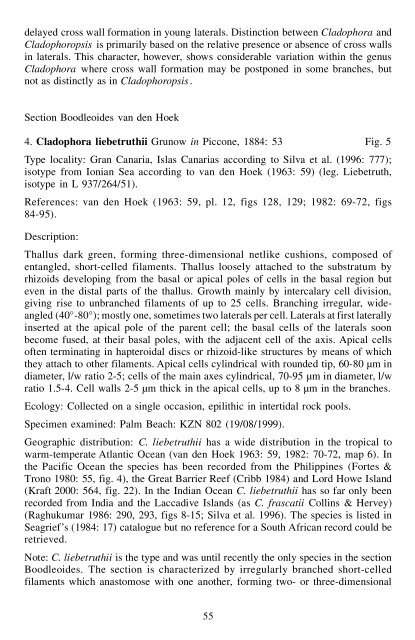The marine species of Cladophora (Chlorophyta) from the South ...
The marine species of Cladophora (Chlorophyta) from the South ...
The marine species of Cladophora (Chlorophyta) from the South ...
You also want an ePaper? Increase the reach of your titles
YUMPU automatically turns print PDFs into web optimized ePapers that Google loves.
delayed cross wall formation in young laterals. Distinction between <strong>Cladophora</strong> and<br />
Cladophoropsis is primarily based on <strong>the</strong> relative presence or absence <strong>of</strong> cross walls<br />
in laterals. This character, however, shows considerable variation within <strong>the</strong> genus<br />
<strong>Cladophora</strong> where cross wall formation may be postponed in some branches, but<br />
not as distinctly as in Cladophoropsis.<br />
Section Boodleoides van den Hoek<br />
4. <strong>Cladophora</strong> liebetruthii Grunow in Piccone, 1884: 53 Fig. 5<br />
Type locality: Gran Canaria, Islas Canarias according to Silva et al. (1996: 777);<br />
isotype <strong>from</strong> Ionian Sea according to van den Hoek (1963: 59) (leg. Liebetruth,<br />
isotype in L 937/264/51).<br />
References: van den Hoek (1963: 59, pl. 12, figs 128, 129; 1982: 69-72, figs<br />
84-95).<br />
Description:<br />
Thallus dark green, forming three-dimensional netlike cushions, composed <strong>of</strong><br />
entangled, short-celled filaments. Thallus loosely attached to <strong>the</strong> substratum by<br />
rhizoids developing <strong>from</strong> <strong>the</strong> basal or apical poles <strong>of</strong> cells in <strong>the</strong> basal region but<br />
even in <strong>the</strong> distal parts <strong>of</strong> <strong>the</strong> thallus. Growth mainly by intercalary cell division,<br />
giving rise to unbranched filaments <strong>of</strong> up to 25 cells. Branching irregular, wideangled<br />
(40°-80°); mostly one, sometimes two laterals per cell. Laterals at first laterally<br />
inserted at <strong>the</strong> apical pole <strong>of</strong> <strong>the</strong> parent cell; <strong>the</strong> basal cells <strong>of</strong> <strong>the</strong> laterals soon<br />
become fused, at <strong>the</strong>ir basal poles, with <strong>the</strong> adjacent cell <strong>of</strong> <strong>the</strong> axis. Apical cells<br />
<strong>of</strong>ten terminating in hapteroidal discs or rhizoid-like structures by means <strong>of</strong> which<br />
<strong>the</strong>y attach to o<strong>the</strong>r filaments. Apical cells cylindrical with rounded tip, 60-80 µm in<br />
diameter, l/w ratio 2-5; cells <strong>of</strong> <strong>the</strong> main axes cylindrical, 70-95 µm in diameter, l/w<br />
ratio 1.5-4. Cell walls 2-5 µm thick in <strong>the</strong> apical cells, up to 8 µm in <strong>the</strong> branches.<br />
Ecology: Collected on a single occasion, epilithic in intertidal rock pools.<br />
Specimen examined: Palm Beach: KZN 802 (19/08/1999).<br />
Geographic distribution: C. liebetruthii has a wide distribution in <strong>the</strong> tropical to<br />
warm-temperate Atlantic Ocean (van den Hoek 1963: 59, 1982: 70-72, map 6). In<br />
<strong>the</strong> Pacific Ocean <strong>the</strong> <strong>species</strong> has been recorded <strong>from</strong> <strong>the</strong> Philippines (Fortes &<br />
Trono 1980: 55, fig. 4), <strong>the</strong> Great Barrier Reef (Cribb 1984) and Lord Howe Island<br />
(Kraft 2000: 564, fig. 22). In <strong>the</strong> Indian Ocean C. liebetruthii has so far only been<br />
recorded <strong>from</strong> India and <strong>the</strong> Laccadive Islands (as C. frascatii Collins & Hervey)<br />
(Raghukumar 1986: 290, 293, figs 8-15; Silva et al. 1996). <strong>The</strong> <strong>species</strong> is listed in<br />
Seagrief’s (1984: 17) catalogue but no reference for a <strong>South</strong> African record could be<br />
retrieved.<br />
Note: C. liebetruthii is <strong>the</strong> type and was until recently <strong>the</strong> only <strong>species</strong> in <strong>the</strong> section<br />
Boodleoides. <strong>The</strong> section is characterized by irregularly branched short-celled<br />
filaments which anastomose with one ano<strong>the</strong>r, forming two- or three-dimensional<br />
55

















